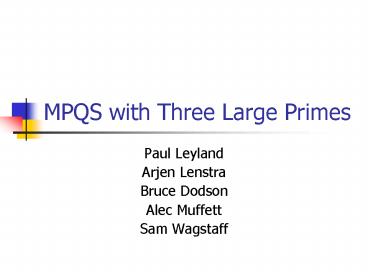MPQS with Three Large Primes - PowerPoint PPT Presentation
1 / 24
Title:
MPQS with Three Large Primes
Description:
Form cycles to eliminate primes B1 ... Crossover at about 10100 ? (PPMPQS crossover at about 1080 and about twice as fast as PMPQS at 10100) This Work ... – PowerPoint PPT presentation
Number of Views:39
Avg rating:3.0/5.0
Title: MPQS with Three Large Primes
1
MPQS with Three Large Primes
- Paul Leyland
- Arjen Lenstra
- Bruce Dodson
- Alec Muffett
- Sam Wagstaff
2
TMPQS Overview
- Given N, select prime bounds B1 and B2
- Sieve for quadratic residues (relations) which
factor over primes lt B1 and at most 3 primes lt B2 - Form cycles to eliminate primes gt B1
- Linear algebra to eliminate primes lt B1 and find
x2 y2 (mod N ) - A factor is gcd (xy, N )
3
Early Experiments with TMPQS
- 1085 lt N lt 10110 , B1 106 , B2 108
- Not significantly worse than PPMPQS
- Perhaps up to 10 faster for larger N
- Crossover at about 10100 ?
- (PPMPQS crossover at about 1080 and about twice
as fast as PMPQS at 10100)
4
This Work
- N 2803 2402 1, aka 2,1606L.c135
- B1 17157953 (550000 primes)
- B2 230
- Sieving at 5 sites, Jan Aug 2001
- 13441627 relations
- N p66 p69
- Approx 8000 MIPS-years
- (Estimate GNFS 1300 MIPS-years)
5
Performance comparison
- Extrapolation from RSA129 on identical hardware
gt 1.7 times - Relation generation rate with different sievers,
extrapolated to completion for PPMPQS gt 1.75
times - Estimate GNFS 6 times faster still
6
Cycle Behaviour
- PMPQS Quadratic growth (birthday paradox)
- PPMPQS Initially quadratic, finally
approximately quartic (RSA-129) - TMPQS Superpolynomial region
7
ln(cycles) vs ln(relations)
8
Large Prime Relations
- par p
- ppr p q
- r
- tpr p q
9
Cycle Types
- S
- D
etc - T
etc
10
ln(S-cycles) vs ln(relations)
11
ln(D-cycles) vs ln(relations)
12
ln(T-cycles) vs ln(relations)
13
Pruning
1
2
3
4
5
6
14
Pruning stages vs relations
15
Cross-linking
16
The Chemical Potential Functions At Phase
Transitions (PW Atkins)
- The changes in thermodynamic properties for a
schematic first-order transition.
Vm
T
?
Sm
T
T
17
Polymer folding (Doye et al.)
18
Q vs T (Doye et al)
1.0
Q
0.5
0.0
Temperature
19
ln(T-cycles) vs ln(relations)
20
Corrected ln(T-cycles) vs ln(rels)
21
Cv vs T (Doye et al)
4000
Cv
2000
0
Temperature
22
Pruning stages vs relations
23
Conclusions
- Despite predictions to the contrary, TMPQS is
faster than PPMPQS for large enough N - Apparently power-law growth in D-cycles and
(initially) T-cycles - Enhancement arises from a phase transition in
T-cycles - Insight from physics chemistry
24
Further work
- Explain polynomial regions of D-cycle and T-cycle
growth are they really 7/2 and 11/2 power-laws? - Better characterize the phase transition in the
T-cycles. - Optimize sieving parameters to bring forward the
onset of the phase transition perhaps by
altering par/ppr/tpr ratio - Similar phenomenon seen in NFS































